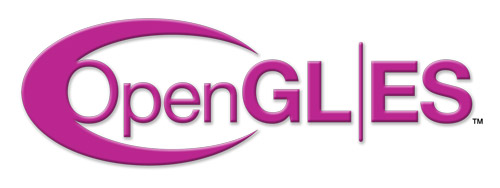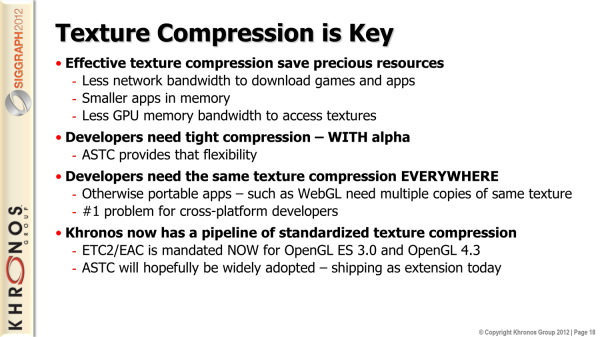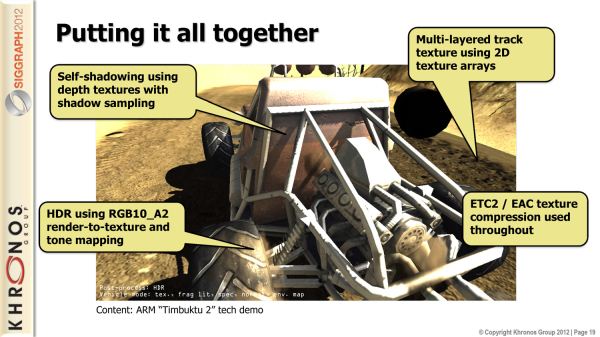Khronos Announces OpenGL ES 3.0, OpenGL 4.3, ASTC Texture Compression, & CLU
by Ryan Smith on August 6, 2012 9:00 AM ESTWhat’s New in OpenGL ES 3.0
In conjunction with next-generation GPUs, OpenGL ES 3.0 will make a number of new features available to mobile and embedded devices. In terms of functionality, OpenGL ES 3.0 is largely a mobile implementation of the OpenGL 3.3 feature set, with a couple notable features missing and a few additional features plucked from later revisions of OpenGL. In terms of backwards compatibility only OpenGL 4.3 is a complete superset of OpenGL ES 3.0, but for most purposes OpenGL 3.1 is probably the closest desktop OpenGL specification.

On that note, though drawing a comparison to Direct3D isn’t particularly straightforward, since we get asked about it so much we’ll try to answer it. Direct3D of course had a major reachitecting with Direct3D 10 back in 2007, which added a number of features to the API while giving Microsoft a chance to clean out a great deal of fixed-function legacy cruft. From a major feature perspective OpenGL did not reach parity with Direct3D 10 until OpenGL 3.2, which among other things introduced geometry shader support.
So if we had to place OpenGL ES 3.0 along a Direct3D continuum, as it’s primarily based on OpenGL 3.1, it would be somewhere between Direct3D feature level 9_3 and feature level 10_0, again primarily due to a lack of geometry shaders. Consequently, this is why some mobile GPUs like Adreno 320 can support OpenGL ES 3.0, but not D3D feature level 10_0. If you only implement the baseline OpenGL ES 3.0 feature set, then it won’t be enough for D3D 10_0 compliance.
Strictly Defined Pixel/Uniform/Frame Buffer Objects
The first major addition to OpenGL ES 3.0 is support for a number of buffer formats, alongside a general tightening up of the buffer format specifications. OpenGL ES 2.0’s buffer format specification had some ambiguity, which lead to GPU vendors sometimes implementing the same buffer format in slightly different ways, which in turn could lead to problems for developers.
OpenGL ES 3.0 also adds support for Uniform Buffer Objects, which is a useful and efficient data buffer type for use with shaders.
GLSL ES 3.0
As is common with most OpenGL releases, OpenGL ES 3.0 includes a new version of the GL ES Shading Langauge, used to program shader effects. The primary addition for GLSL ES 3.0 is full support for 32bit integer and 32bit floating point (i.e. full precision) data types and operations. Previously only lower precisions were supported, which are easier to compute (it takes less hardware and less memory), but as shader complexity increases the relatively large precision errors become even larger.
GLSL ES 3.0 has also seen some syntax and feature tweaks to make it more like desktop OpenGL. This doesn’t change the fact that only OpenGL 4.3 is a complete superset of OpenGL ES 3.0, but it makes it easier for developers used to desktop GLSL to work on GLSL ES and vice versa.
Occlusion Queries and Geometry Instancing
While OpenGL ES 3.0 doesn’t get geometry shaders, it does get several features to help with geometry in general. Chief among these are the addition of occlusion queries and geometry instancing. Occlusion queries allows for fast hardware testing of whether an object’s pixels are blocking (occluding) another object, which is helpful for quickly figuring out whether something can be skipped because it’s occluded. Meanwhile geometry instancing allows the hardware to draw the same object multiple times while only requiring the complete object to be submitted to the rendering pipeline once. This makes trees and other common objects easier for the CPU to set up as it doesn’t need to keep resubmitting the entire object in different locations.
Numerous Texture Features
OpenGL ES 3.0 adds support for a number of texture features; in fact it’s far too many to break down. The big additions are support for floating point textures (to go with the aforementioned FP32 support), 3D textures, depth textures, non-power-of-two textures, and 1 & 2 channel textures (R & R/G).
Multiple Render Targets
Multiple Render Target support allows the GPU to render to multiple textures at once. Simply put, the significance of this feature is that it’s necessary for practical real-time deferred rendering.
MSAA Render To Texture
When rendering to a texture, special consideration must be taken for anti-aliasing, which on earlier hardware generations is only available when run against the framebuffer. OpenGL ES 3.0 will add support for MSAA’d rendering to a texture.
Standardized Texture Compression Format: ETC
Wrapping up our look at OpenGL ES 3.0’s features, we have texture compression. One of the big problems for OpenGL for a number of years was that it didn’t have a standardized texture compression format. In the desktop space the earliest and most common texture compression format is S3TC, which is not available royalty-free, and as such cannot be a part of the core standard (instead only available as an extension). This is a problem that carried over to OpenGL ES, which led to vendors implementing their own incompatible texture compression standards. Among the major OpenGL ES GPUs, S3TC, PVRTC, ETC, and ATITC are the most common texture compression formats.
Because there isn’t a standard texture compression format in OpenGL ES 2.0, developers have to pack their textures multiple times for different hardware, which takes up time and more importantly space. This is a particular problem for Android developers since the platform supports multiple GPUs (versus the PowerVR-only iOS).
For OpenGL ES 3.0, Ericsson has offered up their ETC family of texture compression algorithms on a royalty free basis, allowing Khronos to implement a standard texture compression format and thereby over time resolving the issue of having multiple texture compression formats. Compared to where Khronos eventually wants to go ETC is somewhat dated at this point in time – it only offers 6:1 compression for RGB and 4:1 compression for RGBA – but it will get the job done for now.
For Khronos this is a huge breakthrough since texture compression is even more important on mobile devices than it is desktops, due to the much tighter memory bandwidth requirements. This also allows Khronos to evangelize texture compression to developers who had previously been shying away from using texture compression because of the aforementioned issues.
At the same time it will be interesting to see how developers adopt ETC. Just because it’s a standard doesn’t mean it has to be used, and while we can’t imagine Android developers not using it once OpenGL ES 3.0 is the baseline for applications, Apple bears keeping an eye on. As a PowerVR-only shop they have used PVRTC since day one, and so long as they don’t change to another brand of GPUs they wouldn’t need to actually back ETC.
Of course ETC isn’t the only texture compression format in the pipeline. Khronos is also working on the very interesting ASTC, which we’ll get to in a bit.












46 Comments
View All Comments
djgandy - Tuesday, August 7, 2012 - link
I agree, I did say 'like apple' though, but yes, no one is really interested in desktop GL anymore.At least apple went 3.2 core though and explicitly state in their documentation that deprecated features are removed
https://developer.apple.com/library/mac/#documenta...
Tessellation (Burning energy) aside I don't think there are many headline features that desperately need adding from 4.0 onwards. Apple did only support 2.1 until they released 3.2 support!
Jumangi - Monday, August 6, 2012 - link
Yea DX isn't the stagnated one. OpenGL is a spec has been behind DirectX for years now. The stagnation is from allot of developers who don't use the latest stuff since they stay with the lowest denominator we still have with the PS3 and 360. The features are there if developers want to use them.sheh - Monday, August 6, 2012 - link
And WinXP.ltcommanderdata - Monday, August 6, 2012 - link
It's mentioned in the article that nVidia desktop GPUs don't support ETC in hardware. Do we know whether ETC support in hardware is universal across OpenGL ES 2.0 GPUs from various vendors like PowerVR, ARM, Qualcomm, and nVidia? In the transition, games will no doubt include both OpenGL ES 2.0 and 3.0 render paths to support more devices, and it'd be preferable if both paths could share texture assets.Since ASTC is optional right now which GPU makers have announced they support it in hardware?
It'll be interesting to see what Apple does with ETC on iOS. The existing PVRTC is more efficient on PowerVR GPUs than ETC. I can't see Apple happy to support a less efficient texture format whose benefit to developers but not Apple is to ease portability of games to Android. I suppose Apple will enable ETC support for compatibility, but won't be investing effort in optimizing it's performance. IMG just released a new PVRTC2 texture format for Series5XT and Series6 GPU that improves upon PVRTC, so I expect Apple will be pushing that format soon on iOS.
Ryan Smith - Monday, August 6, 2012 - link
Most current OpenGL ES 2.0 GPUs do not support ETC. I do not have a good list, but I know that PowerVR, Tegra, and Adreno do not support it. So until OpenGL ES 3.0 is the baseline, developers will still have to deal with disjoint texture compression formats. But at least there's finally a way out.As for ASTC, none of the GPU vendors have announced that they'll be supporting it in hardware. This is part of the reason why ASTC is currently being floated as an extension, in order to gather feedback. Now that the standard is out, GPU vendors can look at integrating hardware support. Since this is a joint ARM/NV proposal, I'd expect both of them to integrate support a the earliest opportunity.
pebrb - Monday, August 6, 2012 - link
You are confusing ETC and ETC2 in the entire article.All current OpenGL ES 2.0 GPUs _do_ support ETC (not ETC2) as it is the standard in ES 2.0
The only vendor that doesn't support it is Apple (even though the PowerVS SGX has support for it)
The reason for developers support different texture formats is because ETC is very low quality and lack of alpha channel support.
In OpenGL ES 3.0 they made ETC2 the standard, we'll see how it'll work out.
But I'm waiting for ASTC it has very good features. And from what I heard it will be supported by Microsoft as well, which means that everyone needs to implement it anyway.
name99 - Monday, August 6, 2012 - link
"I can't see Apple happy to support a less efficient texture format whose benefit to developers but not Apple is to ease portability of games to Android."Is any of this conspiracy theory in the slightest grounded in reality?
Apple has generally been happy to support standards, even when that's not directly relevant to its goals. The web world (HTML5 and h264) are obvious examples, but an example more relevant to what we're discussing here is Apple's aggressive support for C++11 (both language and library) in the latest version of XCode. And this is not just passive checkbox support, it is genuine hard work to make C++11 interoperate well with Objective C, and to perform well.
ltcommanderdata - Monday, August 6, 2012 - link
My doubt isn't about Apple supporting standards in general, it's about them supporting a weaker technology as a standard. Apple promotes H.264 over WebM, because it has superior image quality (yes there is some debate) and superior hardware support. With the existing PVRTC texture format on iOS offering better performance and image quality than ETC on the GPUs Apple uses I can't see them singing ETC's praises as a standard. They'll no doubt add iOS support for ETC as it's required for OpenGL ES 3.0, but I don't doubt they'll be strongly encouraging iOS developers to keep using PVRTC and soon PVRTC2.Alexvrb - Monday, August 6, 2012 - link
PVRTC2 will likely wipe the floor with ETC2. Heck it'll probably be better than ASTC too.iwodo - Tuesday, August 7, 2012 - link
Would love to see PVRTC2 Vs ASTC